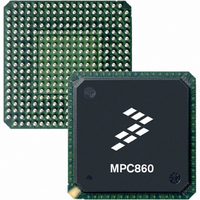MPC8241LVR166D Freescale Semiconductor, MPC8241LVR166D Datasheet - Page 52

MPC8241LVR166D
Manufacturer Part Number
MPC8241LVR166D
Description
IC MPU 32BIT 166MHZ PPC 357-PBGA
Manufacturer
Freescale Semiconductor
Datasheet
1.MPC8241LZQ200D.pdf
(58 pages)
Specifications of MPC8241LVR166D
Processor Type
MPC82xx PowerQUICC II 32-bit
Speed
166MHz
Voltage
1.8V
Mounting Type
Surface Mount
Package / Case
357-PBGA
Processor Series
MPC8xxx
Core
603e
Maximum Clock Frequency
166 MHz
Maximum Operating Temperature
+ 105 C
Mounting Style
SMD/SMT
Minimum Operating Temperature
0 C
Lead Free Status / RoHS Status
Request inventory verification / Request inventory verification
Features
-
Lead Free Status / Rohs Status
Lead free / RoHS Compliant
Available stocks
Company
Part Number
Manufacturer
Quantity
Price
Company:
Part Number:
MPC8241LVR166D
Manufacturer:
Freescale Semiconductor
Quantity:
135
Company:
Part Number:
MPC8241LVR166D
Manufacturer:
Freescale Semiconductor
Quantity:
10 000
Part Number:
MPC8241LVR166D
Manufacturer:
FREESCALE
Quantity:
20 000
Ordering Information
where:
The thermal characterization parameter is measured per JESD51-2 specification using a 40-gauge type T
thermocouple epoxied to the top center of the package case. The thermocouple should be positioned so
that the thermocouple junction rests on the package. A small amount of epoxy is placed over the
thermocouple junction and over about 1 mm of wire extending from the junction. The thermocouple wire
is placed flat against the package case to avoid measurement errors caused by cooling effects of the
thermocouple wire.
When a heat sink is used, the junction temperature is determined from a thermocouple inserted at the
interface between the case of the package and the interface material. A clearance slot or hole is normally
required in the heat sink. Minimizing the size of the clearance minimizes the change in thermal
performance that is caused by removing part of the thermal interface to the heat sink. Considering the
experimental difficulties with this technique, many engineers measure the heat sink temperature and then
back calculate the case temperature using a separate measurement of the thermal resistance of the
interface. From this case temperature, the junction temperature is determined from the junction-to-case
thermal resistance.
In many cases, it is appropriate to simulate the system environment using a computational fluid dynamics
thermal simulation tool. In such a tool, the simplest thermal model of a package that has demonstrated
reasonable accuracy (about 20%) is a two-resistor model consisting of a junction-to-board and a
junction-to-case thermal resistance. The junction-to-case covers the situation where a heat sink is used or
a substantial amount of heat is dissipated from the top of the package. The junction-to-board thermal
resistance describes the thermal performance when most of the heat is conducted to the printed-circuit
board.
7.8
Semiconductor Equipment and Materials International
805 East Middlefield Rd.
Mountain View, CA 94043
(415) 964-5111
MIL-SPEC and EIA/JESD (JEDEC) specifications are available from Global Engineering Documents at
800-854-7179 or 303-397-7956.
JEDEC specifications are available on the web at http://www.jedec.org.
8
Ordering information for the parts that this document fully covers is provided in
Numbers Fully Addressed by This Document.” Section 8.2, “Part Numbers Not Fully Addressed by This
Document,”
These special part numbers require an additional document called a hardware specifications addendum.
52
T
ψ
P
Ordering Information
D
T
JT
References
= thermocouple temperature atop the package (°C)
= power dissipation in package (W)
= thermal characterization parameter (°C/W)
lists the part numbers which do not fully conform to the specifications of this document.
MPC8241 Integrated Processor Hardware Specifications, Rev. 10
Section 8.1, “Part
Freescale Semiconductor









